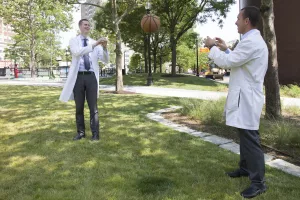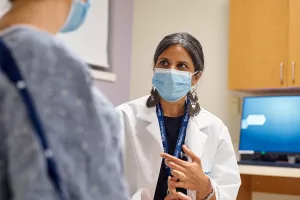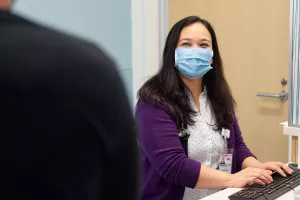When a shoulder, knee or other injury is keeping you on the sidelines, you can count on our team of sports medicine experts to get you moving again. We use the latest techniques to rehabilitate athletes at every level, from the physically active to intramural sports enthusiasts and the pros.
Helping you move better and feel better
No one likes missing out on the action because of an injury, whether it be a playoff matchup or playtime with the kids.
Our team features some of the brightest minds in sports medicine with expertise in the latest surgical techniques, like Mako SmartRobotics™ robotic-arm assisted technology.
Whatever brought you to our program — from milder injuries like a shoulder strain or knee sprain to serious and chronic conditions like knee ligament tears and arthritis — we'll help you get back in the game as safely and quickly as possible.

Conditions
Our team has years of experience in caring for a range of injuries and chronic conditions affecting athletes and the physically active.
- Ankle instability
- Ankle pain, sprains and strains
- Carpal tunnel syndrome
- Early onset arthritis
- Elbow pain
- Fractures
- Foot pain
- Hand pain
- Herniated discs
- Hip pain
- Impingement syndrome
- Knee instability
- Knee ligament injuries (ACL, LCL, MCL and PCL)
- Labral tears
- Patella tendonitis
- Patellofemoral disorders (runner’s knee)
- Refractory trochanteric bursitis
- Shin splints
- Stress fractures
- Tennis elbow
- Throwing injuries
- Wrist pain
Shoulder injuries
Shoulder injuries and disorders are very common. In fact, a research study revealed that up to 26% of adults, or about 1 in 4 people, are dealing with shoulder pain at any given time.
Some common shoulder conditions include:
- Arthritis
- Bursitis
- Dislocations
- Fractures
- Frozen shoulder
- Instability
- Rotator cuff impingement
- Rotator cuff tear
- Separations
- Sprains
- Strains
- Tendinitis
Knee ligament injuries
Did you hear or feel a pop during a sudden change in direction? You may have damaged a knee ligament. The knee joint has 4 main ligaments:
- Anterior cruciate ligament (ACL): runs diagonally through the middle of the knee, preventing the shinbone from sliding forward
- Lateral collateral ligament (LCL): runs along the outside of the knee, preventing the knee from bending outward
- Medial collateral ligament (MCL): runs along the inside of the knee, preventing the knee from bending inward
- Posterior cruciate ligament (PCL): runs diagonally through the middle of the knee, preventing the shinbone from sliding backward
Knee ligaments play a huge role in providing stability and support to the knee, and they absorb a lot of wear and tear as a result.
Testing
We turn to the following imaging tests to get a detailed view of bones, ligaments, organs and tissues affecting your health and mobility:
We also take a hands-on approach to diagnosing sports injuries with a procedure called arthroscopy. It involves making an incision roughly the width of a penny into your joint. We then thread a fiber-optic video camera attached to a narrow tube into the incision to view your joints, tendons and ligaments.
Treatments
Some of the more common procedures we perform include:
- Achilles and other lower extremity tendon repairs
- Cartilage restoration and joint preservation
- Meniscus surgery, such as repairs
We’re also pioneers of minimally invasive surgeries, performing hundreds every year.
On the road to recovery, your plan may include rehabilitation with our partners in physical therapy. Your physical therapist will work with you to create a treatment path tailored to your needs. Part of that path includes a plan for preventing future injuries and even tips on boosting performance in the sports you’re passionate about.
Knee ligament repair
It’s important to note that not all knee ligament tears require surgery. But when your injury interferes with your daily activities like walking up and down stairs, knee ligament repair surgery is a good idea. Going the surgical route is also very common for athletes who want to get back in the game.
There are 3 major goals for knee ligament surgery:
- Limit the loss of function in the knee
- Prevent injury or degeneration to other knee structures
- Restore your knee’s stability
Depending on your age, activity level and the severity of the tear, we may recommend an orthopedic or arthroscopic surgical approach.
We use orthopedic techniques to repair your ligaments with a few small incisions. During this procedure, we:
- Remove the torn ligament from the knee
- Construct a new ligament by using your tendon tissue (autograft) or donor tendon tissue (allograft)
- Rebuild ligament support of the knee by attaching the ligament to the appropriate leg and/or thigh bones
An arthroscopy isn't just for diagnosing injuries. Our doctors also use the extremely narrow tube attached to a fiber-optic camera to thread a new knee ligament through a small incision.
There are 2 key benefits of using an arthroscopic technique for ligament repairs:
- It helps with overall knee stability.
- It decreases the possibility of future ligament ruptures.
Because the incision is so small, you can look forward to:
- Faster recovery times
- Less pain, blood loss and scarring
- Reduced risk of complications
Only about 10% of all orthopedic surgeons can perform this technique, including your orthopedic surgical team at Lowell General Hospital.
Mako SmartRobotics™ Robotic-Arm Assisted Technology
The future of joint replacement is here. The Mako SmartRobotics™ system is a surgical tool that uses a robotic arm to help perform a variety of joint replacement procedures, including:
- Partial knee replacement
- Total hip replacement
- Total knee replacement
Here’s a play-by-play of how it works:
- We take a CT scan of the area, and upload those images to the Mako SmartRobotics™ system.
- The software uses the images to create a 3D model of the injured area.
- Our doctors use the 3D model to help guide the robotic arm during the procedure.
Sports concussion
A concussion is a brain injury caused by a bump, blow or jostle to the head. Concussions can affect people differently depending on what part of the brain was injured. This can lead to a temporary loss of important functions like balance, memory, focus and vision.
You only get one brain, so we treat concussions very cautiously. Little by little, we’ll work to address symptoms and increase therapies without putting too much strain on the brain.
You can also count on our athletic trainers to help create awareness of concussion signs, symptoms and management so that teams can learn and play with a safety-first mentality.

From regular office visits to inpatient stays, find the healthcare you need and deserve close to home.

Meet the doctors and care team devoted to supporting you every step of the way along your path to better health.